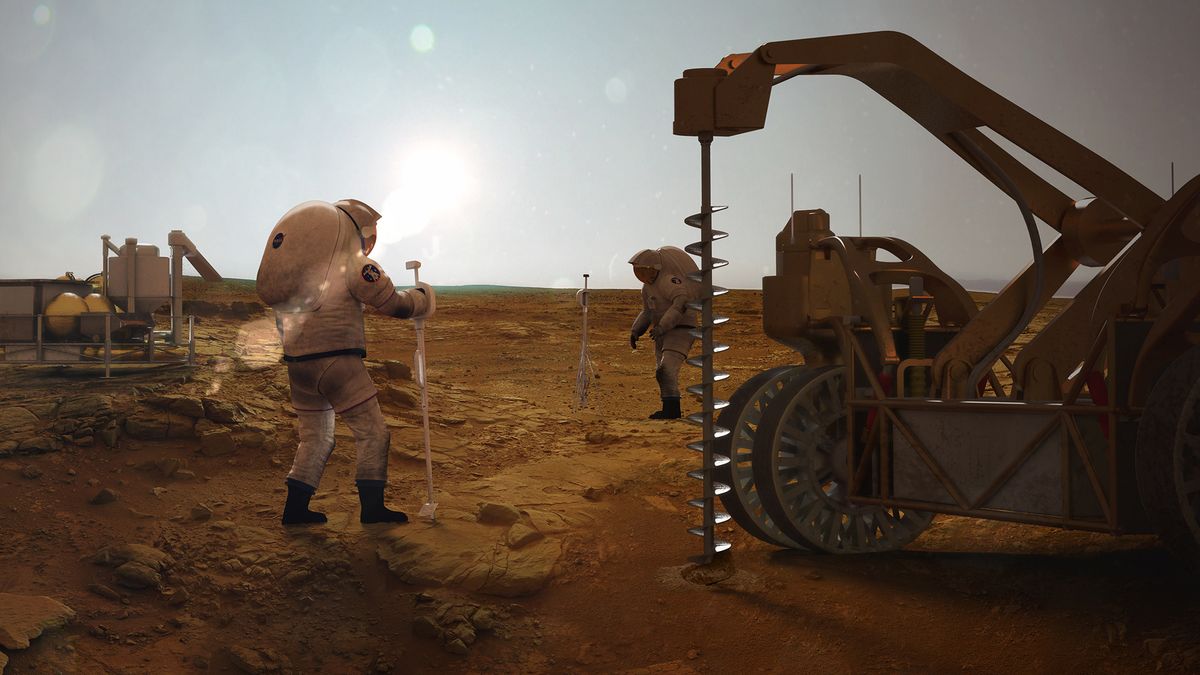
[ad_1]
Settlers on Mars may someday generate fuel and oxygen from the Red Planet’s salt water, according to a new study.
The new technology behind this advance could also help submarines generate oxygen from seawater on Earth, the researchers said.
To live on Mars, all potential colonists will need oxygen to breathe and fuels such as hydrogen gas to power their equipment. Any water they find on the Red Planet will therefore prove invaluable, as they can use electricity and other methods to break down water into hydrogen and oxygen.
Related: How living on Mars could challenge the colonists (infographic)
“Mars is very far out there and we are limited in the amount of things we can take with us, so if we can use the resources already there, it’s cheaper and more feasible than having to drag everything with us,” study Senior author Vijay Ramani, a chemical engineer at Washington University in St. Louis, told Space.com.
Previous research has found that Mars possesses large amounts of ice, and NASA’s Phoenix lander also found signs that the planet’s Arctic plains had been covered in a film of liquid water for the past several million years. Phoenix has also discovered compounds known as perchlorates in Martian soil, which can act as an antifreeze, lowering the freezing point of water beyond its normal temperature.
Since brines containing water and perchlorates can remain liquid even at the cold temperatures found on the Martian surface, Ramani and his colleagues wanted to see if they could use a technique known as electrolysis to split water molecules to form hydrogen and oxygen using the electricity. (The average annual temperature on Mars is about minus 81.4 degrees Fahrenheit, or minus 63 degrees Celsius, though it can vary by more than 212 degrees F, or 100 degrees C, over the course of a day.)
“Electrolysis has been known for about 100 years or more, but it mostly uses pure water as a power source,” Ramani said.
Related: Scientists come up with a new way to make oxygen breathable on Mars

In previous work, Ramani and his colleagues developed materials known as ruthenium lead pyrochlore electrocatalysts that could help them electrolyze seawater. In the new study, their experiments revealed that such catalysts could help electrolyze perchlorate brines, generating ultra-pure hydrogen and oxygen at the kind of ultra-low temperatures found on the Martian surface.
“We can derive oxygen for breathing and hydrogen for fuel using materials on Mars itself, the brackish water now known to be present there,” Ramani said. “Future missions won’t necessarily have to take those components to Mars, but build them in situ with technology like ours.”
Some electricity is needed to drive these chemical reactions. On Mars, such electricity will likely come from solar cells, Ramani noted.
Previously, the Mars Oxygen In-Situ Resource Utilization Experiment (MOXIE) of NASA’s Mars Perseverance rover had shown that it could use electricity to break down carbon dioxide into oxygen and carbon monoxide. For the same amount of power as MOXIE, the new study could generate 25 times more oxygen or more and not generate any toxic carbon monoxide to boot, the researchers said.
“When we talk about exploring space or the surface of the Moon or Mars, it’s never just a technology used – it’s never just a silver bullet that solves all the problems,” Ramani said. “It will take a lot of technologies to work in parallel to make life easier on Mars, and our hope is ours is one of them.”
Scientists have noted that this could help NASA fulfill its current mandate of landing humans on Mars by the mid-1930s. “We hope to be able to interest NASA in an effort to expand this technology and further improve its performance, and in demonstrations in facilities that simulate the Martian environment,” Ramani said.
Such electrocatalysts could also find use on Earth. “If you are in a submarine where there is limited oxygen and there is salt water all around you, you could siphon some of the salt water and divide it to get fresh oxygen,” Ramani said. “In the US Navy, most submarines are nuclear-powered, so there’s no shortage of electricity. For land-based applications, you could even split brackish water to generate hydrogen.”
The scientists detailed their findings online Nov.30 in the journal Proceedings of the National Academy of Sciences.
Follow Charles Q. Choi on Twitter @cqchoi. Follow us on Twitter @Spacedotcom and on Facebook.
Source link